茶艺表演及英文翻译
茶艺表演英文解说词
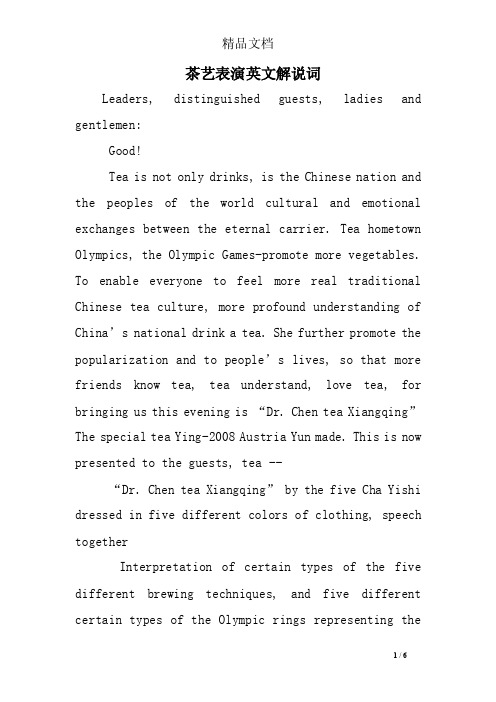
茶艺表演英文解说词Leaders, distinguished guests, ladies and gentlemen:Good!Tea is not only drinks, is the Chinese nation and the peoples of the world cultural and emotional exchanges between the eternal carrier. Tea hometown Olympics, the Olympic Games-promote more vegetables. To enable everyone to feel more real traditional Chinese tea culture, more profound understanding of China’s national drink a tea. She further promote the popularization and to people’s lives, so that more friends know tea, tea understand, love tea, for bringing us this evening is “Dr. Chen tea Xiangqing” The special tea Ying-2008 Austria Yun made. This is now presented to the guests, tea --“Dr. Chen tea Xiangqing” by the five Cha Yishi dressed in five different colors of clothing, speech togetherInterpretation of certain types of the five different brewing techniques, and five different certain types of the Olympic rings representing theyellow and green.Blue, black and red colours.Chinese people emphas ize the “fate”, and Chinese tea and the Olympics are amazing coincidence. Wuhuan flag on the rings with six white color, coincidentally with the traditional Chinese tea Six match. And the pursuit of the Olympic spirit of unity and friendship is’ initiated by the Chinese tea ceremony “and” is so similar to “a Miao.”Next I have the honour to you for leadership. Guests - one who will be introduced Cha Yishi we interpret the signs on behalf of the rings yellow, green, blue, black, red, and so the five tea with tea.Huang Central - yellow tea: Mrs Diana Wong Ip Huang Tang and his name. The main origin in Zhejiang. Sichuan, Hunan, Hubei. To the middle of Yueyang in Hunan’s Dongting Hill, the Junshan silver leaf, “the most representative, was listed as t he top ten tea.” Junshan silver leaf, “as a single bud production, goods drink in the course of the highlights of the Cup Chaya appreciate. King is a permanent special consisting mainly of tea. Hengwo just brewing at thesurf-ace of the water, sinking water Chaya; sharp, in a bubble, like Queshe with beads. Then everyone upright Cup; like Chunsun unearthed; forest such as guns and knives, and then Into the forest at the end, or floating upright again, so from top to bottom ups and downs. Ciqingcijing like t o health. “Three-three” reputation. She Qingxiu very hot. Taste alcohol, Xianshuang. Sweet. Closest after another Have a taste in mind.Central Green tea: After fermentation because it did not fully maintain tea. In the chlorophyll. Vitamin C. Commodities were drinking green tea. Often the first dry tea color. Xiang, shape. Modeling different, or strip or flat. Or spiral-shaped, or if the needle. Its aroma or cream-or-chestnut, or Qingxiang. Brew, the tea can be observed in the slow stretch of water, Yu seven ups and downs. This wealth among the changes the dynamic, tea known as the “tea dance.” After brewing, Tangmianranran increase in the fog mixed with Lvlvchaxiang. Xia Wei Yun like steam. Kuang God and the people. Lin Perspective at tea in front of the sun. Velvet can also see the tiny Tour 7 cents in the water.Glittering. Rui Lin, for small mouth. Goods can be from a tender tea aroma. Qinren have a sense of the heart. Blue Central Qingcha: Green is also an Oriental color. Gouzai “Quan Xue Pian,” said “Qingchuyulan which is better than blue”道出Green stem basket of relations. Qingcha. Also known as Oolong tea, a semi-fermented tea, green tea is a flower and the Qingxiang, a black tea willing to mellow the flavor. Everybody in Zhuansong her beautiful Fengzi. Such as “Green Green Di Yan abdominal end the first,” “Green Jie You Run was brocken spectre”, “Shen clams back”, “Yan Yun,” “Goddeof Mercy rhyme” green-rimmed, three-7 Green, ““ seven to stay Yuxiang bubble. “ And so her skills with the Chinese tea culture integration of the most closely. Such as the “three-for-ding”, “Kuan Kung Xuncheng” “Hanshin point soldiers’” three D to know flavor. Movable to three spring. “ Fully mobilize the “tongue” function. Let tea in rolling back and forth at both ends of the tongue. Let every part of the tongue feel the full taste of tea. Cheek teeth Liuxiang slowly appreciate the feeling. And Central Heicha: Jinya mainly used to make foodsupply frontier minorities. Also known as Bianxiao Cha. She recalled the product may have passed to the Eastern Han Dynasty period of 2000 years of history. If the reward for Aged tea and drink products should be in the proceof carefully appreciate the formation of the “Chen Xiang” inside-the submarine. Wei Chun Kam Waterloo. Because of their unique effectiveneof lipid-lowering diet, be referred to as “Transamerica tea”, “Aerobics tea.”Red Central tea: She’s the great thing, not only is the color Heiheyourun, thick with sweet aroma. Taste great, Tangse Hongyan through yellow, Yedi tender absorbed Hongliang. But also because her temperament moderate, and various spices can be of mutual integration, Xiangying Shenghui. Therefore, the tea drinking, you can drink-and adjustable drink. To truly appreciate its “fragrance, flavor and color to the” goods “from top to bottom the word Yao, as appropriate to drink slowly, carefully made up for, slowly appreciate, aloof自得” eat “a tea Zhenwei, really enjoy This Fufen.“Hill well, water well. Buddhism smile withouttrouble; to hurry to rush, tea Jibei the West East.”。
茶艺表演自我介绍用英语

茶艺表演自我介绍用英语Tea ceremony is a centuries-old cultural tradition in many Asian countries, particularly Japan and China. It is an exquisite art form that combines the preparation and presentation of tea with the appreciation of beauty in the form of unique tea utensils, the serene atmosphere, and the mindful experience of the ritual. As a practitioner of this ancient art, I am honored to have the opportunity to introduce myself and share my passion for the tea ceremony.My name is [Your Name], and I have been studying and perfecting the art of tea ceremony for the past [X] years. From a young age, I was captivated by the elegance and tranquility of this cultural tradition, and I have dedicated myself to mastering every aspect of the tea ceremony. Through my training, I have not only learned the technical skills required to properly prepare and serve tea, but I have also developed a deep appreciation for the philosophy and aesthetics that underpin this art form.At the heart of the tea ceremony is the concept of wabi-sabi, which embraces the beauty of imperfection and the transient nature of allthings. This philosophy is reflected in the carefully curated selection of tea utensils, each with its own unique character and history. From the delicately handcrafted tea bowl to the rustically simple bamboo whisk, every item used in the ceremony is imbued with a sense of quiet dignity and simplicity.As I perform the tea ceremony, I strive to embody the principles of wabi-sabi, moving with a graceful and measured pace that allows the guests to fully immerse themselves in the moment. Each step of the process, from the meticulously prepared matcha powder to the final presentation of the tea, is carried out with the utmost care and attention to detail. It is my goal to create an atmosphere of serenity and contemplation, where the guests can momentarily escape the bustling outside world and find solace in the peaceful ritual of tea.Beyond the technical aspects of the tea ceremony, I have also dedicated myself to understanding the historical and cultural significance of this art form. The tea ceremony has its roots in the Zen Buddhist tradition, and the practice of mindfulness and self-reflection is a crucial aspect of the experience. Through my studies, I have gained a deep appreciation for the rich tapestry of history and philosophy that underlies the tea ceremony, and I strive to share this knowledge with my guests in a way that enhances their appreciation and understanding of the art.During the tea ceremony, I take great care to guide my guests through the various stages of the ritual, explaining the significance of each step and the symbolic meaning behind the utensils and gestures. I believe that this educational component is a vital part of the experience, as it allows the guests to gain a deeper understanding and connection to the cultural traditions that have been passed down through generations.As I perform the tea ceremony, I am always mindful of the importance of creating a harmonious and tranquil atmosphere. I carefully select the appropriate music, incense, and lighting to complement the mood of the ceremony, and I strive to maintain a calm and centered presence that sets the tone for the entire experience. By creating this serene environment, I hope to transport my guests to a place of contemplation and inner peace, where they can momentarily escape the stresses of the outside world and immerse themselves in the timeless beauty of the tea ceremony.Throughout my journey as a tea ceremony practitioner, I have been privileged to share this art form with people from all walks of life, from seasoned connoisseurs to those who are new to the experience. It is always my greatest joy to witness the transformative power of the tea ceremony, as my guests emerge from the ritual with a renewed sense of calm, clarity, and appreciation for the beauty of the natural world.As I continue to hone my skills and deepen my understanding of the tea ceremony, I am constantly inspired by the rich cultural heritage and timeless wisdom that this art form represents. It is my sincere hope that through my performances and teachings, I can help to preserve and share this profound tradition with future generations, so that the beauty and philosophy of the tea ceremony can continue to enrich and inspire people around the world.Thank you for the opportunity to introduce myself and share my passion for the art of tea ceremony. I look forward to the chance to perform for you and your guests, and to create an unforgettable experience of tranquility, beauty, and cultural appreciation.。
中国茶道专业名词英语

中国茶道专业名词英语Chinese Tea Ceremony Professional Terminology in EnglishIntroduction:China's tea culture is renowned worldwide, with a long history and profound traditions. The Chinese Tea Ceremony, also known as Cha Dao, is an art form that encompasses the deep appreciation of tea and the accompanying rituals. This article aims to provide a comprehensive guide to Chinese Tea Ceremony professional terminology translated into English. By understanding these terms, you can delve into the rich heritage of Chinese tea and enhance your tea-tasting experience.1. Types of Chinese Teas:1.1. Green Tea - 绿茶(lǜ chá)Green tea is the most commonly consumed tea in China. It undergoes minimal oxidation during processing, resulting in its distinct taste and appearance.1.2. Black Tea - 红茶 (hóng chá)Black tea, also known as red tea in China, is fully fermented before being dried. It has a rich flavor and deep red color.1.3. Oolong Tea - 乌龙茶(wū lóng chá)Oolong tea falls between green and black tea in terms of oxidation. It is known for its floral and fruity taste profiles.1.4. White Tea - 白茶 (bái chá)White tea is the least processed tea variety, with minimal oxidation. It offers a delicate and subtle flavor.1.5. Yellow Tea - 黄茶 (huáng chá)Yellow tea is a specialty in China, undergoing a unique processing method that includes slight oxidation and fermentation.1.6. Pu'er Tea - 普洱茶(pǔ'ěr chá)Pu'er tea is a post-fermented tea that is famous for its distinct earthy taste. It originates from the Yunnan province of China.2. Tea Preparation:2.1. Tea Leaves - 茶叶 (chá yè)Refers to the processed leaves of the tea plant Camellia sinensis used for making tea.2.2. Tea Set - 茶具 (chá jù)A collection of utensils, including teapots, tea cups, and tea trays, used for brewing and serving tea.2.3. Infusion - 冲泡(chōng pào)The process of steeping tea leaves in water to extract the flavors and aromas.2.4. Brewing - 泡制 (pào zhì)The method of preparing tea by adding water to the tea leaves and allowing them to steep for a specific period.2.5. Gongfu Tea - 工夫茶(gōng fū chá)A precise and elaborate tea brewing technique that requires skill and precision.3. Tea Tasting and Appreciation:3.1. Aroma - 香气(xiāng qì)The pleasant fragrance that emanates from the brewed tea leaves.3.2. Flavor - 口感(kǒu gǎn)The taste characteristics and sensations experienced when drinking tea, including sweetness, bitterness, and astringency.3.3. Aftertaste - 回甘(huí gān)The lingering taste and sensations that remain in the mouth after swallowing tea.3.4. Tea Evaluation - 茶评 (chá píng)The process of assessing tea quality based on factors such as appearance, aroma, flavor, and overall experience.3.5. Tea Ceremony - 茶艺表演(chá yì biǎo yǎn)A formal presentation and demonstration of the Chinese Tea Ceremony, showcasing the artistry and rituals involved in tea preparation.Conclusion:Understanding the professional terminology related to Chinese Tea Ceremony in English enhances the appreciation and enjoyment of this ancient tradition. By familiarizing yourself with the types of Chinese teas, the tea preparation process, and the terms used in tea tasting and appreciation, you can embark on a journey of exploring the intricacies of Chinese tea culture. So, grab your tea set, steep a cup of your favorite tea, and immerse yourself in the soul-soothing world of Chinese tea. Cheers!。
绿茶茶艺与英文翻译
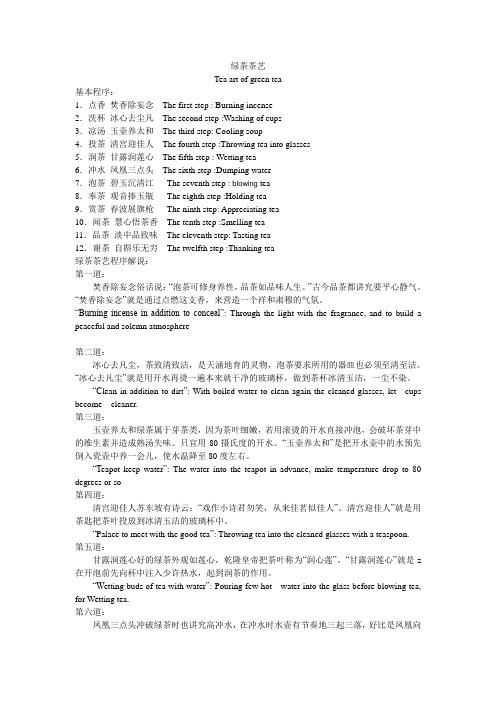
“Palace to meet with the good tea”:Throwing tea intothecleaned glasseswith a teaspoon.
第五道:
甘露润莲心好的绿茶外观如莲心,乾隆皇帝把茶叶称为“润心莲”。“甘露润莲心”就是z在开泡前先向杯中注入少许热水,起到润茶的作用。
“Teapot keep water”:The water into theteapotinadvance, make temperature drop to 80 degrees or so
第四道:
清宫迎佳人苏东坡有诗云:“戏作小诗君勿笑,从来佳茗似佳人”。清宫迎佳人”就是用茶匙把茶叶投放到冰清玉洁的玻璃杯中。
“The phoenixthree nods”: Dumping waterthreeup anddown withrhythmic.
第七道:
碧玉沉清江冲入热水后,茶先是浮在水面上,而后慢慢沉入杯底,我们称之为“碧玉沉清江”。
“Jade issinkinggreenriver”Tea first float on the water, and then slowly sank to the bottom of the cup.
2.洗杯冰心去尘凡The second step :Washing of cups
茶道的专业用语 英语版

茶道的专业用语英语版凉(药)茶herbal tea, medicinal tea粗茶叶 coarse leaves头春茶early spring tea, first season tea头道茶first infusion of tea茶末tea dust茶丸tea ball粉末茶tea powder煎茶fried tea芽茶but-tea新茶fresh tea石专茶brick tea毛茶crudely tea散茶loose tea碎茶broken tea香片perfumed tea茶片,tea siftings花茶scented(jasmine) tea茶叶梗tea stale, tea stem沏新茶making fresh tea上茶offering tea, tea serving淡茶weak tea浓茶strong tea抿茶sipping tea茶园tea garden茶馆tea house茶儿tea table茶篮tea basket滤茶球tea ball减肥茶diet(slimming)tea保健茶tonic tea凉茶精herb ingredients美容茶cosmetic tea人参茶ginseng tea姜茶ginger tea速溶茶instant tea茶叶蛋salty eggs cooked in tea 擂茶mashed tea盖碗茶tea served in a set of cups 茶叶表演tea-serving performance早茶morning tea 茶锈tea stain茶底tea dregs茶脚waste tea茶渣tea grounds茶香tea aroma茶具tea set茶杯tea cup茶盘tea tray茶碟tea saucer茶壶tea pot茶缸tea container紫砂茶壶ceramic tea pot茶叶罐tea caddy茶杯垫coaster茶壶套tea cosy滤茶器tea strainer茶匙teaspoon黑茶、压制茶术语干茶形状术语泥纵条fishery茶条圆直较大,状如泥爆。
茶道英语介绍带翻译
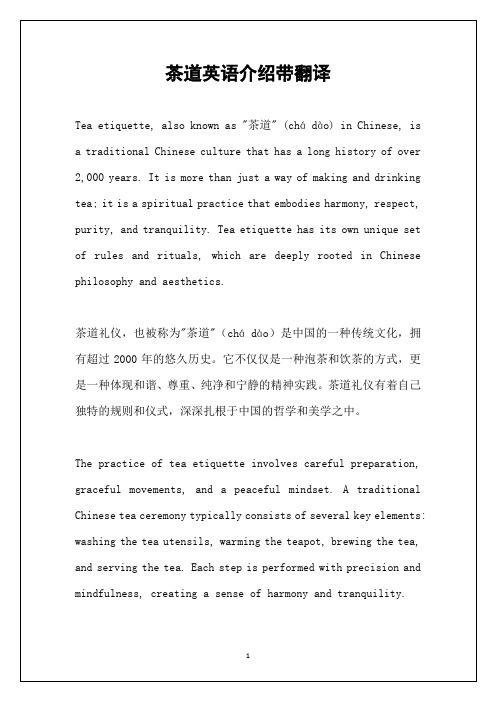
There are several key phrases and expressions in Chinese that are commonly used in the context of tea etiquette. Understanding these terms can enhance one's appreciation of Chinese tea culture and make the tea-drinking experience more enjoyable and meaningful. Here are some essential phrases related to tea etiquette, along with their English translations:
1. 茶道 (chá dào) - Tea etiquette
2. 泡茶 (pào chá) - Brewing tea
3. 茶具 (chá jù) - Tea utensils
4. 茶艺表演 (chá yì bi ǎo yǎn) - Tea art performance
5. 茶道师傅 (chá dào shī fù) - Tea master
茶道英语介绍带翻译
Tea etiquette, also known as "茶道" (chá dào) in Chinese, is a traditional Chinese culture that has a long history of over 2,000 years. It is more than just a way of making and drinking tea; it is a spiritual practice that embodies harmony, respect, purity, and tranquility. Tea etiquette has its own unique set of rules and rituals, which are deeply rooted in Chinese philosophy and aesthetics.
茶艺表演及英文翻译

茶艺表演及英文翻译茶艺表演中英文对照品尝茶类:CLASSIFICATION:一、绿茶:碧螺春、龙井Green Tea: Green Spiral (Biluochun Tea), Dragon well, Tippy Tea二、乌龙茶:大红袍、铁观音Oolong: Dahongpao Tea (Wuyi Mountain Rock Tea), Tieh-Kuan-Yin三、花茶:菊花、茉莉花茶Scented Tea: Chrysanthermum Tea, Jasmine Tea四、黑茶:熟普、生普Black Tea: Pu er Tea大红袍茶艺Dahongpao Process世界自然、文化双遗产地武夷山,不仅是风景名山,文化名山,而且是茶叶名山。
提起武夷山,不少茶人都知道,这里是红茶和乌龙茶的发源地,如今盛产武夷岩茶。
提起武夷岩茶,则普天下茶人都渴望能有幸品到中国茶王——大红袍。
(出场)The World Natural and Cultural Heritage, Wuyi Mountain, is not only famous for its view and culture, but also tea. When talking about Wuyi Mountain, many people recognize that it is the cradle of black tea and oolong. The most known is the Wuyi Mountain Rock Tea, the King of Chinese tea --- Dahongpao.第一道:迎接茶王Process 1 Welcome大红袍是清代供皇上饮用的茶中的极品,乾隆皇帝曾在品饮后写诗评价说:武夷茶品质最佳,最有韵味。
”现在我们就请各位嘉宾“当回皇帝,品尝茶王——大红袍。
Dahongpao is dedicated to emperor in Qing dynasty. Emperor Qianlong had written a poem for Dahongpao: there is nothing better than Wuyi Tea both quality and taste.第二道:喜遇知己Process 2 Observation先请大家欣赏茶叶。
常见英文标识牌语的翻译错误

专注标识标牌行业15年常见英文标识牌语的翻译错误1.拼写错误例如:“月光旅馆(Moon Hotel)”被拼写成了“Moon Hotle”;在银行“储蓄(Saving)”被拼写成了“Saviny”。
“上了阳朔码头怎麽走,电动车载你在画中游。
”翻译成了“do you go after landing yangshuo dock? Electric cans will take you to hace a beautiful trip”,在这里“cans”应该是“vans”and“hace’应该是“have”。
2.语法错误例如:“旅游箱包”—“Tourist Case and Bag”应该是“Tourist Cases and Bags”;“男式服饰用品”—“Man’s accessories”应该是“Men’s accessories”。
“停车场”被翻译成了“Park”,and而正确的翻译应为“Parking”。
“她的美让绚丽的世界黯然失色”—“Her beautiful made the bright world dim.”应该是“Her beauty made the bright world dim”。
3.中式英语例如:“请保持环境卫生”被翻译成了“Please Keep the Environment sanitation”。
这是典型的中式英语.正确的翻译是“Please Keep the Place Clean and Tidy ”。
“公共厕所”.许多场所将其翻译成了“WC”,不太文雅。
应该被翻译成“Restroom”或者“Men’s room,Women’s room”。
4.文化误读例如:“民族园”is translated as “Racist Park种族歧视园”。
种族在国外是一个敏感的话题而“racist”意思是有种族歧视的人,这样翻译是十分不妥的。
“茶艺表演”—“Tea Skill Performance(茶技表演)”。
关于中国茶文化的英语词汇语块和句式表达
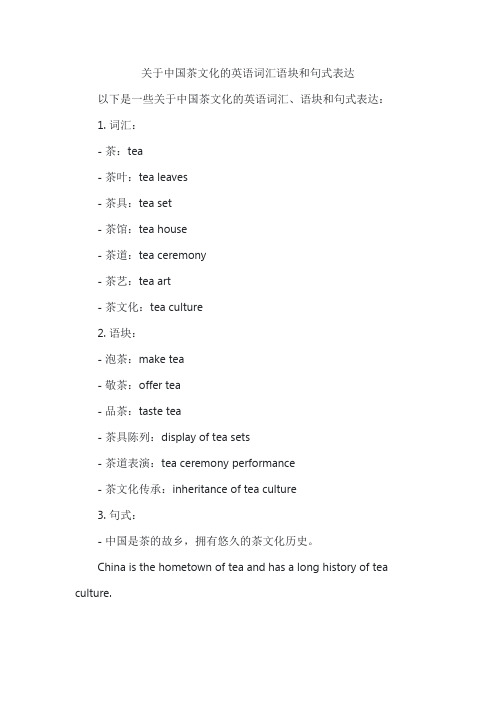
关于中国茶文化的英语词汇语块和句式表达以下是一些关于中国茶文化的英语词汇、语块和句式表达:1. 词汇:- 茶:tea- 茶叶:tea leaves- 茶具:tea set- 茶馆:tea house- 茶道:tea ceremony- 茶艺:tea art- 茶文化:tea culture2. 语块:- 泡茶:make tea- 敬茶:offer tea- 品茶:taste tea- 茶具陈列:display of tea sets- 茶道表演:tea ceremony performance- 茶文化传承:inheritance of tea culture3. 句式:- 中国是茶的故乡,拥有悠久的茶文化历史。
China is the hometown of tea and has a long history of tea culture.- 茶道是一种通过泡茶、敬茶和品茶等环节来表达敬意和感恩的艺术形式。
Tea ceremony is an art form that expresses respect and gratitude through the procedures of making, offering and tasting tea.- 茶文化是中国传统文化的重要组成部分,它体现了中国人对生活品质和精神追求的追求。
Tea culture is an important part of Chinese traditional culture, embodying the Chinese people's pursuit of life quality and spiritual pursuit.- 中国的茶馆是人们休闲、社交和品尝茶文化的好去处。
Chinese tea houses are good places for people to relax, socialize and experience tea culture.- 学习茶道可以帮助人们提高修养、培养内心平静和增进人际关系。
茶艺解说(英文版)

Good afternoon, Dear leaders, teachers and students:China is the homeland of tea and tea culture. Offering tea is a traditional chinese courtesy. We are going to performance oolong tea for everyone.1.Silk and Bamboo ensembleThe tea one will say there will be a tea party may only life. So very pious heart to do the preparatory work, waiting for the arrival of guests in a happy mood.2. Prepared cups to welcome guestsTeapot is made in Yixing of Jiangsu province.It is dual pore structure of Pot inner wall ,the water absorption and permeability is superb.Also known as fair cup of tea sea for average tea, in order to make a fair and equitable ItalyTea cup cup spacious, easy to appreciate Tangse products tea soupSmells cup, the tall cup of smells, easy hot incense and Lengxiang of smell take tea3. Warm potFirst warm pot later into the tea brewing hot water from the hot and cold disparityWarm cup, warm filter4.Boutique AppreciationWe are brewing Tieguanyin of Anxi today.5.GuanYin in palacePut the tea in teapot. Sushi ‘s poem said good tea is like a beautiful girl. Putting the tea lightly is just like inviting the girl to room, live odor everywhere.6. Moist teaWarm tea, Small pots of tea, mostly spherical semi-fermented tea so the first warm bubble, tight end bubble tea loose, can maintain the same shades of tea stirred up color7 lotus pond fragranceSmall tea sea, tea inject the tea was blowing can go darkened cleared spirit broken troubles8.Hanging pot rushed highLet the tea infiltrate fully in water9. Mornring Ou CupOolong tea brewing pay attention to head bathing tea thirty-four bubble the essence so generally do not drink tea soup for hot wash smells cup or directly into the sea of tea10.Tea cooked fragrant temperaturePouring tea,Shades moderate pour the tea into the tea sea, exudes a warm tea, tea first pour tea sea points each guest a cup down on each guest a cup of tea concentration can be the same, so the tea sea akafair cup11.Tea sea Chi HongPoints tea into the cupThe Chinese say the full sommelier Zhencha seventh of eight full master Zhencha divided rich and poor pour each guest in seventh of the full to with shades of tea brewed in the same pot as Guanyin salvation equality12 .fish big splashThe legendary Big Splash is immortal, I wish to take this do you rise higher and higher.13. Respect and SilenceTea cup of tea every confidant willing to bring you a peaceful and healthy enjoy. Thank you, ladies and gentlemen, our performance ends watch。
完成 茶艺表演
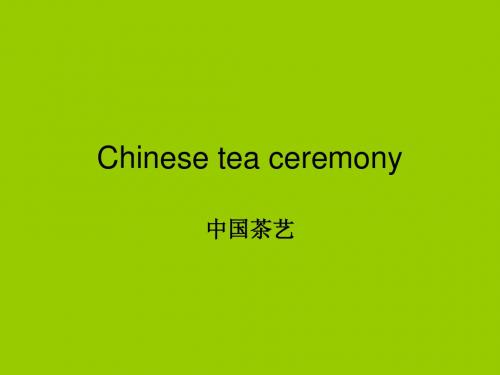
2 茶夹tea-tongs for picking up teacups
3茶匙tea-spoon for helping to put tea into the teapot
4茶针tea-needle for clean the spout
5茶漏tea-funnel for putting dry tealeaves into the teapot
品茗杯 teacup for drinking tea
茶洗 tea-strainer for preventing tealeaves into tea water
茶盂container for deserted water
茶罐 tea-caddy for keeping dry tealeaves
第九道:重洗仙颜
• Pour boiling water into the first teapot again
第七道: 关公巡城 韩信点兵
• Way of pouring tea water into every teacup for enjoying sweet smell
第八道:捧杯敬茶
Having a cup of tea satisfies a desire of sitting alone and thinking.
One can think over what he has done in the past and what he will do in the future. He can draw conclusions about what life is from his own experiences.
第五道:乌龙入宫
• Put tea into the teapot
茶艺翻译英语作文
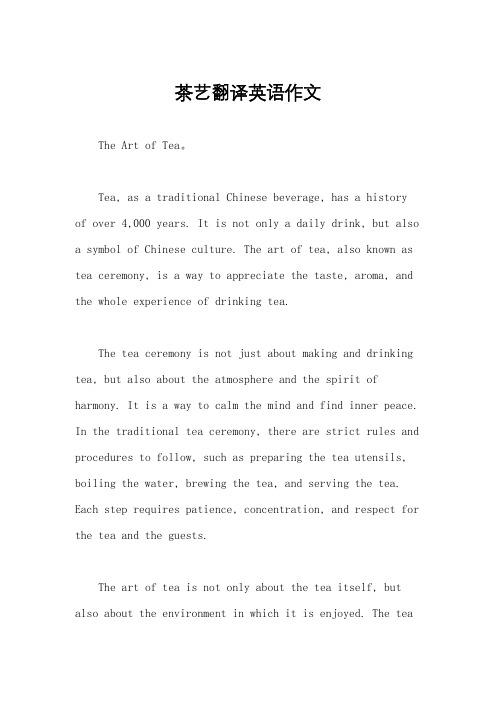
茶艺翻译英语作文The Art of Tea。
Tea, as a traditional Chinese beverage, has a history of over 4,000 years. It is not only a daily drink, but also a symbol of Chinese culture. The art of tea, also known as tea ceremony, is a way to appreciate the taste, aroma, and the whole experience of drinking tea.The tea ceremony is not just about making and drinking tea, but also about the atmosphere and the spirit of harmony. It is a way to calm the mind and find inner peace. In the traditional tea ceremony, there are strict rules and procedures to follow, such as preparing the tea utensils, boiling the water, brewing the tea, and serving the tea. Each step requires patience, concentration, and respect for the tea and the guests.The art of tea is not only about the tea itself, but also about the environment in which it is enjoyed. The tearoom is usually designed to create a peaceful and tranquil atmosphere, with simple and elegant decorations. The host of the tea ceremony will pay attention to every detail, from the arrangement of the tea utensils to the choice of tea leaves, in order to create a harmonious and enjoyable experience for the guests.There are many different types of tea in China, each with its own unique flavor and aroma. Some of the most famous types of Chinese tea include green tea, black tea, oolong tea, white tea, and pu-erh tea. Each type of tea has its own brewing method and specific tea utensils, which adds to the complexity and beauty of the tea ceremony.In addition to the traditional Chinese tea ceremony, there are also many other tea cultures around the world, such as the Japanese tea ceremony, the English afternoon tea, and the Moroccan mint tea. Each tea culture has its own customs and traditions, but they all share the same spirit of hospitality, respect, and appreciation for theart of tea.The art of tea is not only a way to enjoy a delicious and healthy beverage, but also a way to connect with nature, culture, and people. It is a way to slow down andappreciate the simple pleasures of life. In today's fast-paced world, the art of tea can serve as a reminder to take a break, relax, and enjoy the present moment.In conclusion, the art of tea is a beautiful and meaningful tradition that has been passed down through generations. It is a way to appreciate the beauty of nature, the richness of culture, and the warmth of human connections. Whether you are a tea lover or not, the art of tea is something that everyone can learn from and appreciate. So, next time you have a cup of tea, take a moment to savor the taste, aroma, and the whole experienceof the art of tea.。
中国茶道表演文案英语

中国茶道表演文案英语Chinese Tea Ceremony PerformanceIntroduction:The Chinese tea ceremony, also known as the Way of Tea, is a traditional and culturally significant practice in China. It embodies principles of hospitality, respect, and mindfulness while showcasing the art of tea preparation and serving. This article aims to provide an overview of the Chinese tea ceremony and its importance in Chinese culture.Section 1: A Brief History of Chinese Tea CeremonyThe Chinese tea ceremony dates back to the Tang dynasty (618-907) and has since become an integral part of Chinese culture. It originated from Buddhist and Daoist rituals and quickly spread among the scholar and aristocratic class. Over time, different tea ceremonies evolved in different regions of China, each with unique characteristics and styles.Section 2: The Art of Chinese Tea CeremonyThe Chinese tea ceremony is not only a process of brewing and serving tea; it is a refined art form that requires precision and grace. The following are the key components of a typical Chinese tea ceremony performance:1. Tea Utensils:The tea ceremony utilizes several traditional utensils, including a tea pot, tea cups, tea tray, tea scoop, and tea strainer. Each utensil serves a specific purpose and adds elegance to the ceremony.2. Tea Selection:High-quality loose-leaf tea is preferred for the Chinese tea ceremony. The choice of tea depends on the occasion, season, and personal preference. Common types of tea used include green tea, oolong tea, black tea, and pu-erh tea.3. Tea Preparation:The tea master carefully measures the tea leaves, pours hot water into the tea pot, and allows the tea to steep for a specific time. The art lies in achieving the optimum brewing time to extract the tea's unique flavors and aromas.4. Tea Serving:Once the tea is ready, the tea master pours it into small cups while maintaining a steady hand to ensure an equal and consistent amount is poured for each guest. The cups are then presented to the guests with a respectful gesture.Section 3: Symbolism and SignificanceThe Chinese tea ceremony is more than just a demonstration of tea preparation; it holds deep cultural and symbolic significance. Some of the key aspects include:1. Hospitality and Respect:Through the act of serving tea, hosts express their respect and gratitude to their guests. Each movement, from preparing the tea to serving it, is done with utmost care and consideration.2. Mindfulness and Tranquility:The tea ceremony emphasizes the importance of being present in the moment and appreciating the simple pleasures of life. It provides a tranquil and meditative experience for both the tea master and the guests.3. Social Connection:The Chinese tea ceremony promotes social cohesion and bonding. It provides an opportunity for friends, family, and acquaintances to come together, share stories, and appreciate tea as a common interest.Section 4: Modern Adaptations and CommercializationIn recent years, the Chinese tea ceremony has gained popularity worldwide, not only as a cultural practice but also as a form of entertainment. Many cultural centers, tea houses, and tourist attractions now offer tea ceremony performances to showcase Chinese traditions to a global audience.However, it is important to note that while commercialized versions of the tea ceremony may cater to tourists, traditional tea ceremonies still hold immense cultural value and should be respected for their authenticity.Conclusion:The Chinese tea ceremony is a rich tradition that has been passed down through generations and continues to play a significant role in Chinese culture. Its artistry and symbolism make it a unique and cherished practice. By understanding and appreciating the Chinese tea ceremony, one gains insight into the values and customs of this ancient civilization and can experience a profound connection to the rich history of China.。
茶道表演过程英语与翻译
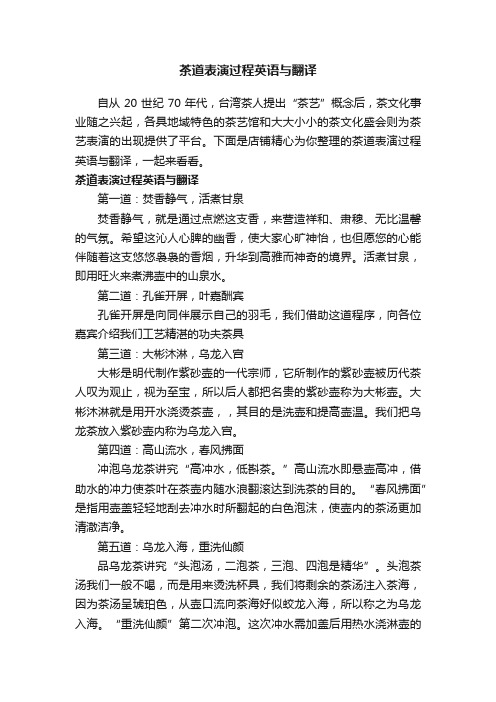
茶道表演过程英语与翻译自从20世纪70年代,台湾茶人提出“茶艺”概念后,茶文化事业随之兴起,各具地域特色的茶艺馆和大大小小的茶文化盛会则为茶艺表演的出现提供了平台。
下面是店铺精心为你整理的茶道表演过程英语与翻译,一起来看看。
茶道表演过程英语与翻译第一道:焚香静气,活煮甘泉焚香静气,就是通过点燃这支香,来营造祥和、肃穆、无比温馨的气氛。
希望这沁人心脾的幽香,使大家心旷神怡,也但愿您的心能伴随着这支悠悠袅袅的香烟,升华到高雅而神奇的境界。
活煮甘泉,即用旺火来煮沸壶中的山泉水。
第二道:孔雀开屏,叶嘉酬宾孔雀开屏是向同伴展示自己的羽毛,我们借助这道程序,向各位嘉宾介绍我们工艺精湛的功夫茶具第三道:大彬沐淋,乌龙入宫大彬是明代制作紫砂壶的一代宗师,它所制作的紫砂壶被历代茶人叹为观止,视为至宝,所以后人都把名贵的紫砂壶称为大彬壶。
大彬沐淋就是用开水浇烫茶壶,,其目的是洗壶和提高壶温。
我们把乌龙茶放入紫砂壶内称为乌龙入宫。
第四道:高山流水,春风拂面冲泡乌龙茶讲究“高冲水,低斟茶。
”高山流水即悬壶高冲,借助水的冲力使茶叶在茶壶内随水浪翻滚达到洗茶的目的。
“春风拂面”是指用壶盖轻轻地刮去冲水时所翻起的白色泡沫,使壶内的茶汤更加清澈洁净。
第五道:乌龙入海,重洗仙颜品乌龙茶讲究“头泡汤,二泡茶,三泡、四泡是精华”。
头泡茶汤我们一般不喝,而是用来烫洗杯具,我们将剩余的茶汤注入茶海,因为茶汤呈琥珀色,从壶口流向茶海好似蛟龙入海,所以称之为乌龙入海。
“重洗仙颜”第二次冲泡。
这次冲水需加盖后用热水浇淋壶的外部,这样内外加温有利于茶香的散发。
第六道:玉液回壶,再注甘露把紫砂壶中的茶汤注入公道杯中,称之为“玉液回壶、再注甘露”第七道:祥龙行雨,凤凰点头将公道杯中的茶汤快速均匀地斟入闻香杯中,称为“祥龙行雨”,取其“甘露普降”的吉祥之意。
当公道杯中的茶汤所剩不多时则应改为点斟的手法,这里形象地称之为“凤凰点头”,以示向嘉宾行礼致敬。
介绍茶艺表演英语作文
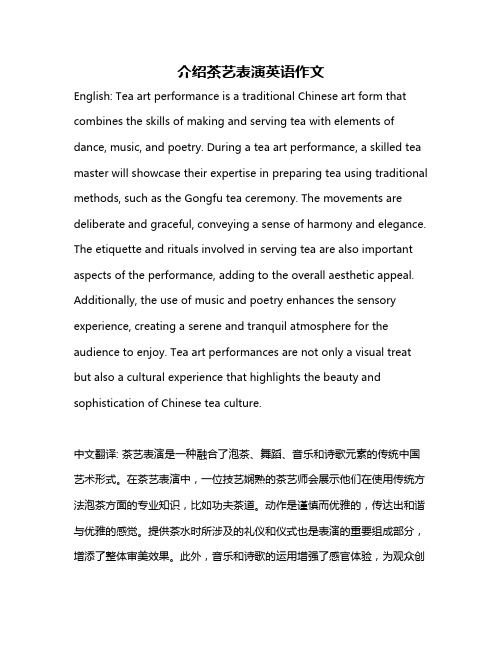
介绍茶艺表演英语作文English: Tea art performance is a traditional Chinese art form that combines the skills of making and serving tea with elements of dance, music, and poetry. During a tea art performance, a skilled tea master will showcase their expertise in preparing tea using traditional methods, such as the Gongfu tea ceremony. The movements are deliberate and graceful, conveying a sense of harmony and elegance. The etiquette and rituals involved in serving tea are also important aspects of the performance, adding to the overall aesthetic appeal. Additionally, the use of music and poetry enhances the sensory experience, creating a serene and tranquil atmosphere for the audience to enjoy. Tea art performances are not only a visual treat but also a cultural experience that highlights the beauty and sophistication of Chinese tea culture.中文翻译: 茶艺表演是一种融合了泡茶、舞蹈、音乐和诗歌元素的传统中国艺术形式。
中国茶道英文介绍带翻译

中国茶道英文介绍带翻译Chinese Tea Ceremony Introduction茶道是中国传统文化的重要组成部分,深受人们的喜爱和尊重。
它不仅代表了一种饮茶习俗,更是一种修身养性的艺术形式。
中国茶道带有独特的哲学理念和礼仪规范,通过精心的准备和品味,传达着对生活的热爱和追求完美的态度。
在本文中,我们将介绍中国茶道的背景、茶具、茶艺以及茶道的意义。
Background茶道起源于中国,已有数千年的历史。
古人将茶叶视为珍贵的礼品,而喝茶的过程则视为一种仪式。
茶道最早由禅宗修行者引入,并在宋朝时扩展为一种流行的饮茶文化。
茶道成为儒家文化以及贵族和士人们追求修身养性的重要方式,并渐渐发展为一种深深植根于中国社会的精致艺术形式。
Teaware中国茶道强调茶具的精细制作和品质。
茶具被视为茶道的重要组成部分,其造型、材质和工艺都在体现茶道的精神。
常用的茶具有茶壶、茶杯、茶托、茶碟等。
茶壶通常选用紫砂陶器,因其能够保持茶水的温度和味道,进而提升茶的口感和香气。
茶杯也有许多种类,其中最著名的是薄胎杯,其瓷质细腻,能够使茶汤更好地展现出色泽和香气。
Tea Artistry中国茶道以其雅致和精妙的茶艺而闻名。
茶艺师必须研究不同种类的茶叶,并掌握煮水、泡茶的技巧。
茶艺师需要根据茶叶的种类以及泡茶的时间和温度来决定如何煮水和调整泡茶的方法。
一场完美的茶道表演需要茶艺师的高超技艺和专注力。
茶艺表演通常由茶艺师在静谧的环境中进行,以确保观众能够专注地品味茶的香气和味道。
Meaning of Tea Ceremony中国茶道不仅仅是一种饮茶方式,更是一种对生活的态度和追求。
茶道强调的是沉浸于当下的意识和舒缓的心灵状态。
通过品茶,人们可以放松身心,感受茶叶的馥郁香气,体会与自然的和谐以及内心的宁静。
茶道也强调人与人之间的交流和分享。
在茶道中,人们通常会邀请亲朋好友一起品茗,共同享受茶香和友谊。
茶道通过一杯茶,将人们的心灵紧密联系在一起。
英语口语练习:茶馆里的茶艺表演

英语口语练习:茶馆里的茶艺表演英语口语练习:茶馆里的茶艺表演为帮助同学们讲得一口流利的生活口语,店铺收集了以下文章,希望对您有所帮助。
茶馆里的茶艺表演Laura:Do you think there will be a show of the Chinese tea ceremony?这里会有茶艺表演的展示吗?Benjamin:Of course. It's a tea culture festival. So there should be many shows about that. Look, there is one over there. Let's go and have a look.当然有。
这是茶文化节。
所以应该会有很多茶艺表演。
看,那边有一个。
我们过去看看吧。
Laura:He looks very professional. What's the most important thing about a tea ceremony?他看起来好专业哦。
茶艺表演中最重要的是什么?Benjamin:Well, the Chinese tea ceremony emphasizes the tea, rather than the ceremony.这个啊,相对于仪式,中国的茶艺更加注重茶本身。
Laura:You mean what the tea tastes like?你是指茶的味道吗?Benjamin:Yeah. And also, what it smells like and how one tea tastes compared to the previous tea.是的。
也包括茶闻起来的香味,以及先后品茶味道的比较。
Laura:What do you mean by “previous tea”?你说的“之前的茶”是指什么?Benjamin:A good server can make a pot of tea serve 3 or 4 rounds and up to 5 or 6. The goal is that each round tastes the same as the first.一个出色的茶艺表演者可以让一壶茶叶泡3或4次甚至多达5或6次。
茶艺解说(英文版)
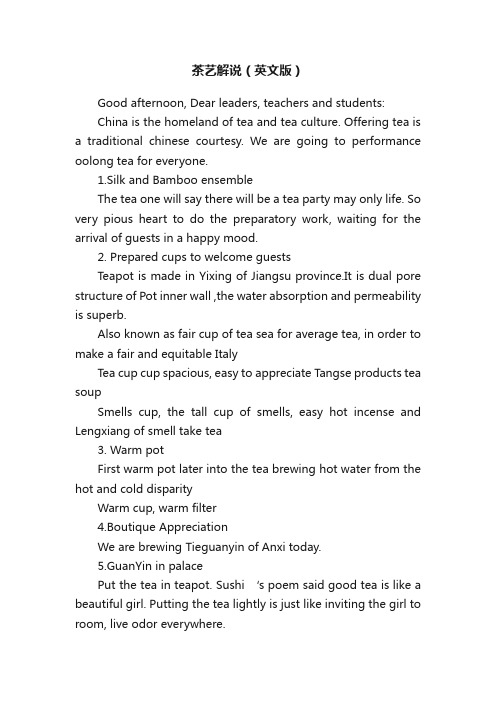
茶艺解说(英文版)Good afternoon, Dear leaders, teachers and students:China is the homeland of tea and tea culture. Offering tea is a traditional chinese courtesy. We are going to performance oolong tea for everyone.1.Silk and Bamboo ensembleThe tea one will say there will be a tea party may only life. So very pious heart to do the preparatory work, waiting for the arrival of guests in a happy mood.2. Prepared cups to welcome guestsTeapot is made in Yixing of Jiangsu province.It is dual pore structure of Pot inner wall ,the water absorption and permeability is superb.Also known as fair cup of tea sea for average tea, in order to make a fair and equitable ItalyTea cup cup spacious, easy to appreciate Tangse products tea soupSmells cup, the tall cup of smells, easy hot incense and Lengxiang of smell take tea3. Warm potFirst warm pot later into the tea brewing hot water from the hot and cold disparityWarm cup, warm filter4.Boutique AppreciationWe are brewing Tieguanyin of Anxi today.5.GuanYin in palacePut the tea in teapot. Sushi ‘s poem said good tea is like a beautiful girl. Putting the tea lightly is just like inviting the girl to room, live odor everywhere.6. Moist teaWarm tea, Small pots of tea, mostly spherical semi-fermented tea so the first warm bubble, tight end bubble tea loose, can maintain the same shades of tea stirred up color7 lotus pond fragranceSmall tea sea, tea inject the tea was blowing can go darkened cleared spirit broken troubles8.Hanging pot rushed highLet the tea infiltrate fully in water9. Mornring Ou CupOolong tea brewing pay attention to head bathing tea thirty-four bubble the essence so generally do not drink tea soup for hot wash smells cup or directly into the sea of tea10.Tea cooked fragrant temperatureShades moderate pour the tea into the tea sea, exudes a warm tea, tea first pour tea sea points each guest a cup down on each guest a cup of tea concentration can be the same, so the tea sea akafair cup11.Tea sea Chi HongPoints tea into the cupThe Chinese say the full sommelier Zhencha seventh of eight full master Zhencha divided rich and poor pour each guest in seventh of the full to with shades of tea brewed in the same pot as Guanyin salvation equality12 .fish big splashThe legendary Big Splash is immortal, I wish to take this do you rise higher and higher.13. Respect and SilenceTea cup of tea every confidant willing to bring you a peaceful and healthy enjoy. Thank you, ladies and gentlemen, ourperformance ends watch。
茶艺表演的英语作文
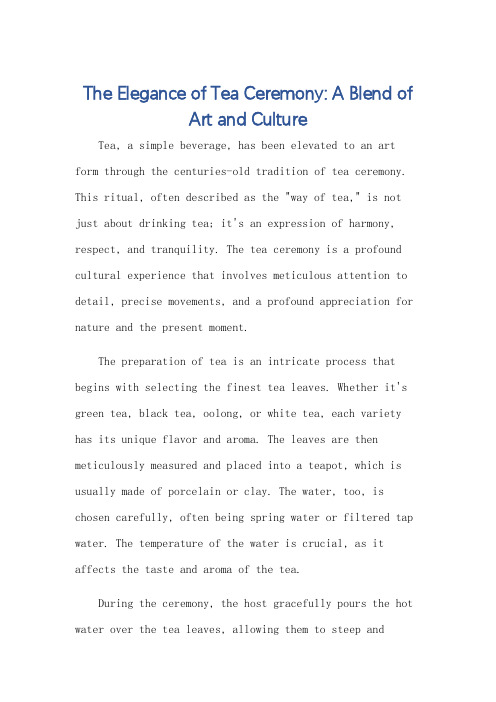
The Elegance of Tea Ceremony: A Blend ofArt and CultureTea, a simple beverage, has been elevated to an art form through the centuries-old tradition of tea ceremony. This ritual, often described as the "way of tea," is not just about drinking tea; it's an expression of harmony, respect, and tranquility. The tea ceremony is a profound cultural experience that involves meticulous attention to detail, precise movements, and a profound appreciation for nature and the present moment.The preparation of tea is an intricate process that begins with selecting the finest tea leaves. Whether it's green tea, black tea, oolong, or white tea, each variety has its unique flavor and aroma. The leaves are then meticulously measured and placed into a teapot, which is usually made of porcelain or clay. The water, too, is chosen carefully, often being spring water or filtered tap water. The temperature of the water is crucial, as it affects the taste and aroma of the tea.During the ceremony, the host gracefully pours the hot water over the tea leaves, allowing them to steep andrelease their essence. The process is slow and deliberate, giving the participants time to appreciate the beauty ofthe moment. The host then carefully pours the brewed teainto small cups, offering them to the guests with both hands. This act symbolizes respect and humility.The tea ceremony is not just about drinking tea; it's also about sharing and connecting with others. It's a wayof life that promotes tranquility, harmony, and inner peace. The ceremony is often accompanied by traditional music, poetry readings, or flower arrangement, further enhancingthe aesthetic experience.In China, the tea ceremony is considered a form of meditation. It's a way to quiet the mind, focus on the present, and appreciate the simple pleasures of life. The movements and rituals of the ceremony are designed to bring about a sense of calm and tranquility, allowingparticipants to connect with their inner selves and the universe.The tea ceremony is also a powerful form of cultural expression. It's a way for people to share their traditions, values, and way of life with others. By participating in atea ceremony, one not only enjoys the taste of tea but also gains a deeper understanding of the culture and history behind it.In conclusion, the tea ceremony is much more than just drinking tea. It's a blend of art, culture, andspirituality that brings people together and creates asense of harmony and tranquility. It's a beautiful way to appreciate the simple pleasures of life and connect with oneself and others.**茶艺表演的优雅:艺术与文化的融合**茶,这种简单的饮品,通过数百年的茶艺传统被提升到了艺术的高度。
- 1、下载文档前请自行甄别文档内容的完整性,平台不提供额外的编辑、内容补充、找答案等附加服务。
- 2、"仅部分预览"的文档,不可在线预览部分如存在完整性等问题,可反馈申请退款(可完整预览的文档不适用该条件!)。
- 3、如文档侵犯您的权益,请联系客服反馈,我们会尽快为您处理(人工客服工作时间:9:00-18:30)。
茶艺表演及英文翻译茶艺表演及英文翻译茶艺表演中英文对照品尝茶类:CLASSIFICATION:一、绿茶:碧螺春、龙井Green Tea: Green Spiral (Biluochun Tea), Dragon well, Tippy Tea二、乌龙茶:大红袍、铁观音Oolong: Dahongpao Tea (Wuyi Mountain Rock Tea), Tieh-Kuan-Yin三、花茶:菊花、茉莉花茶Scented Tea: Chrysanthermum Tea, Jasmine Tea皇帝,品尝茶王——大红袍。
Dahongpao is dedicated to emperor in Qing dynasty. Emperor Qianlong had written a poem for Dahongpao: there is nothing better than Wuyi Tea both quality and taste.第二道:喜遇知己Process 2 Observation先请大家欣赏茶叶。
在山清水秀的良好环境中,生产的大红袍品质优良。
历代爱茶的皇帝,都为大红袍的知音。
希望各位嘉宾也能像各代皇帝一样,成为它的知己。
First of all, let’s look into the tea-leaf. With an excellent living condition, it is no need to worry about its quality. In all ages, every tea-lover-emperor is a bosom friend of Dahongpao. We wish you; our dear customers, will also be a bosom friend of Dahongpao, like the emperors.第三道:温暖茶壶Process 3 Warm the teapot明代有位制作紫砂壶的名师——时大彬,他制作的紫砂壶贵逾黄金,被后人叹为观止,所以我们常把紫砂壶称为“大彬壶”。
泡茶前先温热茶壶。
In Ming dynasty, there was a professor who was good at making purple clay teapot called Shi dabin. The purple clay teapot he made was more precious than gold, and was honored by the world. Consequently, we usually call purple clay teapot as “Da Bin Pot”. Please warm the teapot before making a cup of tea.第四道:茶王入宫殿Process 4 King in the Palace即把大红袍请入茶壶。
Put Dahongpao tea-leaf into teapot第五道:高山流水Process 5 Lofty Mountains and Flowing River倾注的热水,如武夷山的瀑布在鸣奏着大自然的乐章,希望这高山流水能激起您心中的共鸣。
The pouring hot water sounds like that the Wuyi Mountain waterfall playing the music of nature. We hope that it will rise your resonance.第六道:乌龙入海Process 6 Oolong goes into the sea大红袍属于乌龙茶类,其汤色是橙黄色,我们把茶汤出,称为“乌龙入海”。
In Chinese saying, long means dragon. Dahongpao belong to Oolong, the colour of Dahongpao is orange. We filtrate the tea, call it Oolong goes into the sea.第七道:一帘幽梦Process 7 Sweet Dreams第二次冲入开水后,茶与水在壶中相融合。
这时,还要继续在壶外浇淋开水,以便让茶释放出茶味。
这种神秘的感觉,正如一帘幽梦。
After a second-time brew up, tea leaf and water fuse together. At this time, we still need to pour boiling water outside the teapot to release the taste of tealeaf. This makes us feel like Sweet dreams.第八道:美汤移入壶中Process 8 Transfer into another teapot冲泡时,避免大红袍在壶中长时间保留,因为这样会使茶水苦涩。
我们把泡好的茶倒入公道壶称之为“玉液移壶”。
When brewing up, the taste will get bitter if the tealeaf being soaked for a long time. We will put the tea into another teapot.第九道:精华均分Process 9 Share将茶水均匀分到杯中,使每杯浓淡相同称精华均分,也代表茶道中众生平等的精神。
Pour out the tea averagely. This represents the spirit of all creature are created equal by God.第十道:奉献茶王Process 10 Give out即把冲泡好的大红袍奉给各位。
请品茶。
Deliver the tea to guests.第十一道:鉴赏双色Process 11 observe the color大红袍的茶汤清澈艳丽,表面呈现油亮的光圈,可鉴赏这由浅到深的颜色。
The colour of Dahongpao is limpid, from light to dark.第十二道:细闻天香Process 12 Smell大红袍的茶香突出、持久,像梅花,如兰花,甜润又温馨。
多种香型巧妙地混合在一起,飘散空中,变化无穷,被茶人称之为“天香”。
The scent of Dahongpao is prominent as well as lasting, somewhat like plum blossom, somewhat like orchid.第十三道: 细品奇茗Process 13 Taste茶在中国,不但是一种礼仪,更是一种哲理。
有诗言:红红炭火清清水,满座茶香四海情。
我们将一杯香茗奉给各位,以表示茶人的热情,愿各位细细品尝大红袍,感受浓浓的中国情。
In China, tea not only stands for etiquette, more like philosophy. Let’s pick up the cup and enjoy the Dahongpao, taste the tea, taste the chinese.乌龙(铁观音)茶艺Oolong(Tieh-Kuan-Yin) tea ceremony主持:欢迎各位来宾能在百忙之中抽空参加我们的茶艺品鉴活动!今天为我们带来精彩茶艺表演的是高级茶艺师罗方。
Presider: Welcom to our tea tasting event! Today, Luo Fang, the advanced tea master, will give us a wonderful performance. Let’s welcome our tea master.请大家和我分享茶艺的快乐,功夫茶艺共有十道程序,下面为各位一一演示。
LF: Thank you. It’s my honor to share the happiness of tea ceremony with you all. There are ten programs about Kong Fu Tea and I will present them to you one by one.第一道:孔雀开屏,观赏美叶First: Like a peacock, appreciating beautiful tea leaves孔雀开屏:指孔雀在展示美丽的羽毛,这里我们也向大家一一介绍功夫茶茶具:茶盘;这是宜兴制作的紫砂壶,紫砂壶一向为爱茶人士所喜爱,它色泽光润,具有良好的吸水性,长期冲泡会留有茶香,外部也更润滑。
公道壶,用来均匀茶汤,茶先倒入公道壶再分给来宾,可便每杯浓淡相同,体现中国茶艺对来宾共等对待,无分贵贱;这是闻茶香用的闻杯;这是品茶用的品杯。
茶匙,用于量取茶叶;茶夹,用于夹杯;茶漏,可防止茶叶撒落;茶向导,拨取茶叶;茶针,这是疏通壶嘴用的。
茶罐,用于存放茶叶;茶荷花,用于装茶叶以供观看外形。
现在我们用茶匙把茶叶放入茶荷中。
观赏美叶:请大家观赏茶叶的外形色泽。
它颜色墨绿、外形紧结。
Peacock: It refers to a peacock showing its beautiful feather. Here, I would like to introduce the tea set of Kong Fu Tea to you.Tea tray: This is a ceramic tea pot made in Yixing. Ceramic tea pots have always been favored by those who love tea, with the bright and bloom color and good water absorptivity. Besides, the tea aroma will stay in the pot after a long time of making tea. What’s more, the external part of the pot will be more smooth than before.Fair pot: It is used to make the tea ingredient. First, put the tea into the Fair pot and then distribute it to guests,so that the guests can drink neither too weak nor too strong tea, which shows that Chinese Tea Ceremony is respectful to every guest. This is When cup used to smell the tea, and this is Pin Cup used to taste the tea.Teaspoon is used to measure the amount of tea; Tea folder is used to cramp the tea cup; Tea strainers is to prevent tea spilled; Tea Wizard is used to take tea; Tea needle is used to clear the spout. Tea caddy is used to store tea. Tea holder is used to put the tea in and view its shape.Now, we put the teaspoon into the tea holder.Watching the beautiful tea leaves: Please watch the shape and the color of tea. It is dark green with the shape tight knot.第二道:温暖茶壶,乌龙入宫Second: To warm the tea pot, Oolong coming into the palace.(ceramic tea pot is compared to palace)泡茶前先用开水浇热茶壶,可以洗壶提高壶温;明代有位制作紫砂壶的名师——时大彬,他制作的紫砂壶贵逾黄金,被后人叹为观止,所以我们常把名贵的紫砂壶统称为大彬壶;今天为大家冲泡的是铁观音,铁观音是乌龙茶中的一种,它产于福建安溪,现在把茶叶放到壶中,称为乌龙入宫殿。
